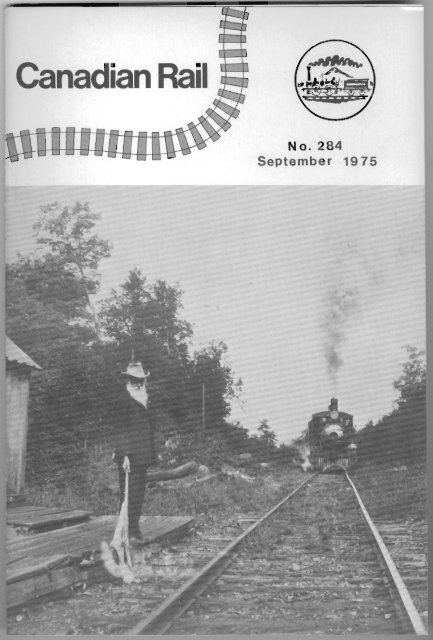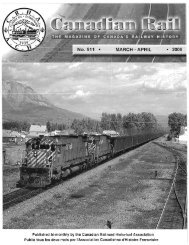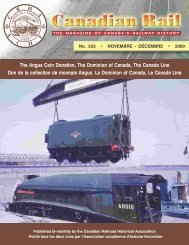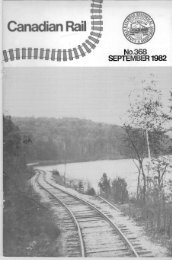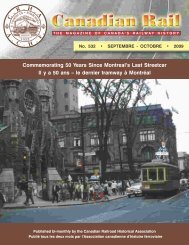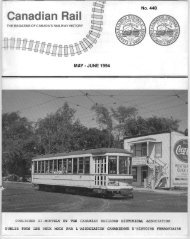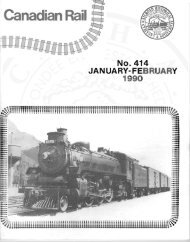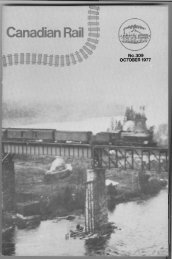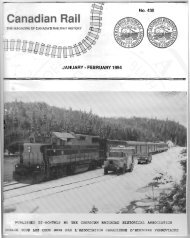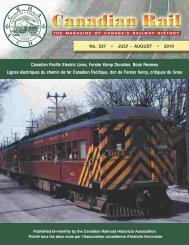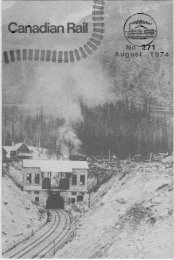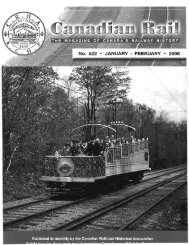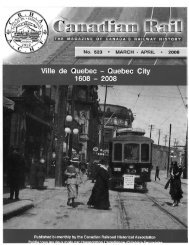Canadian Rail i
Canadian Rail i
Canadian Rail i
You also want an ePaper? Increase the reach of your titles
YUMPU automatically turns print PDFs into web optimized ePapers that Google loves.
<strong>Canadian</strong> <strong>Rail</strong> i<br />
No. 284<br />
September 1975
The Story of Passenger, Freight,<br />
Ski and Other Trains from Montreal<br />
to the Laurentian Mountains.<br />
M. Peter Murphy<br />
Part II -<br />
<strong>Canadian</strong> National <strong>Rail</strong>ways<br />
Editor's Note: Part I of this three-part article was<br />
presented in the February 1975 issue Number 277 of<br />
CANADIAN RAIL.<br />
Part III will be presented in a forthcoming<br />
issue of our magazine.<br />
CN<br />
in the Laurentian Mountains.<br />
While the <strong>Canadian</strong> Pacific <strong>Rail</strong>way was preparing to extend its<br />
line from St-Jerome to Labelle, Quebec, under the charter powers of<br />
the Montreal and Western <strong>Rail</strong>way Company, the Montfort Colonization<br />
<strong>Rail</strong>way Company was incorporated 6n 2 April 1890. The prime mover<br />
in this enterprise was none other than Cure Fran90is-XavierAntoine<br />
Labelle, who now turned his organizing abilities to the settlement<br />
of the river valleys to the west of the Riviere du Nord, which would<br />
not be accessible via the Montreal and Western.<br />
The new railway was slightly different, in that it was planned<br />
and built a s a "chemin de fer economique" or narrow-gauge line, of<br />
a gauge of 3 feet. Construction began at Montfort Junction, near<br />
today's Vimy Siding on CP RAIL north of Shawbridge, Quebec, in the<br />
autumn of 1893 and the standards to which this 36-inch-gauge line<br />
was built could only be described as primitive. Apparently, the surveyed<br />
route was cleared of trees and the stumps and roots were used<br />
IDENTIFIED AS THE STATION AT MONTFORT, QUEBEC, ABOUT 1905, THE PASsenger<br />
train is hauled by an engine with a round number plate, suggesting<br />
that it is a <strong>Canadian</strong> Northern engine. The patriarch on the<br />
left seems to be flagging the train, but he is obviously more interested<br />
in having his picture taken~ Photo collection F.F.Angus.<br />
~THE BRIDGE ABUTMENT OF THE NARROW-GAUGE MONTFORT COLONIZATION RAILway<br />
on the east side of the Riviere du Nord near Piedmont, Quebec,<br />
as it looked in 1972. This part of the Montfort line was abandoned<br />
in 1907 • Photo by the Author.
I<br />
CANADIAN 264 R A I L<br />
-;-,.<br />
.. ,~<br />
as fill for the low spots. Years later, when the stumps had rotted,<br />
the result was a number of serious subsidences on the line.<br />
From this first Montfort Junction, about two miles south of CP<br />
RAIL's present-day station of Piedmont and directly across the North<br />
River from St-Sauveur' s modern water-filtration plant, the narrowgauge<br />
Montfort Colonization <strong>Rail</strong>way curved to the west and crossed<br />
the North River, climbing up the hillside to the St-Sauveur valley.<br />
Traces of this right-of-way may be seen today in the bridge abutments<br />
on the banks of the Riviere du Nord, suspicious curves in<br />
pasture fences and traces of the grade, visible from the road leading<br />
to the ItS ki-Avila" ski a rea.<br />
The Montfort Colonization <strong>Rail</strong>way was completed in stages, the<br />
first being from (old) Montfort Junction to Morin Flats (today, the<br />
village of Morin Heights), a distance of about 10 miles. The first<br />
three-foot-gauge train made the trip over the new line in the spring<br />
of 1894. The line was subsequently extended to the settlement on<br />
the shores of Sixteen Island Lake and the first train over the<br />
whole line of about 21 miles ran on 8 March 1895.<br />
The extension from Morin Flats to Sixteen Island Lake was, to<br />
say the very least, a difficult stretch of railway to operate. The<br />
curves were tight and the grades were steep and, despite the alleged<br />
suitability of the narrow-gauge motive power to this kind of<br />
operation, the trains had their problems in overcoming the grades at<br />
Lac Chevreuil and Orphanage Hill at Montfort. The former, a grade of<br />
about 210 feet to the mile, remained unaltered after the Montfort<br />
Colonization was standard-gauged in 1898 and the last train to Montfort<br />
and Lac Remi in 1962, albeit diesel-hauled, had to take a good<br />
run to make the hill without doubling it.<br />
The origin of the 36-inch-gauge equipment for the Montfort Colonization<br />
<strong>Rail</strong>way is not certain, but it is believed to have been<br />
acquired from the Lake Temiscamingue Colonization <strong>Rail</strong>way Company<br />
(incorporated 20 july 1886) of northwestern Qu'bec. Poor's "Manual<br />
of <strong>Rail</strong>roads" for 1894-95 records the following motive power and<br />
rolling stock on the Montfort Colonization <strong>Rail</strong>way:<br />
Steam locomotives 2<br />
Coaches, first-class 1<br />
Coaches, second-class 1<br />
Baggage cars 1<br />
Boxcars 2<br />
Platform (flat) cars 19<br />
In 1895, the year service was inaugurated to Sixteen Island<br />
Lake, Father St-Pierre of the village of St-Sauveur-des-Monts wrote<br />
a letter to Monsieur T. de Montigny, colonization agent for the<br />
Government of Qu'bec:<br />
"The Parish of St-Sauveur-des-Monts gives me the impression<br />
of a sick person who is slowly recovering. The decrease<br />
in the population and revenues of some years ago suggests<br />
to me that St-Sauveur has passed through a very bad period.<br />
However, these days, the Parish seems to have regained its<br />
former strength. What are the reasons for this? Probably<br />
there are many advantages that favour it. Two railways are<br />
crossing the Parish, agriculture is doing well here as<br />
everywhere else and noticeable progress is being made every<br />
year.
CANADIAN 26' R A I L<br />
I'<br />
I<br />
\ ~<br />
I<br />
This year, five of my parishoners (Messieurs Elie<br />
Desjardins, Casimir Latour, Lambert Belanger, Joseph Plouffe,<br />
Adelard Forget and Jean-Baptiste Gohier) have received<br />
certificates, two were honoured by agricultural societies,<br />
whose members may be held up as examples by their work.<br />
Everything seems to be prosperous here. We have an<br />
agricultural society which, although small at the beginning,<br />
is growing day by day; three butter factories are<br />
prospering; three merchants seem ta be doing well, together<br />
with many other small store-owners; two nice, wellkept<br />
hotels; two doctors who are earning their living quite<br />
honorably; all trades can be found in the neighbourhood and<br />
are well encouraged and patronized and, except for a tinsmith,<br />
we have everything."<br />
From this optimistic communication, it is easy to imagine the<br />
kind of life that the residents of a Laurentian community enjoyed<br />
in the year of Our Lord 1895. The two railways referred to were,<br />
of course, the Montreal & Western (CPR), which had helped to develope<br />
the eastern side of the ~arish of St-Sauveur-des-Monts since<br />
1892 and the more recent Montfort Colonization <strong>Rail</strong>way of 1894,<br />
which passed right through the centre of the Parish and the village<br />
of St-Sauveur.<br />
As built, the MCR was never extended beyond Sixteen Island<br />
Lake but, on 13 June 1898, the company was reorganized and emerged<br />
as the Montfort & Gatineau Colonization <strong>Rail</strong>way, with powers to<br />
build between the Riviere du Nord and the valley of the Gatineau<br />
River, some miles to the west. With fresh plans for expansion in<br />
mind and conscious of the interchange possibilities with the <strong>Canadian</strong><br />
Pacific, the old Montfort Colonization line was standard-gauged<br />
in the summer of 1897. The brief, difficult, three-year life of the<br />
Montfort narrow-gauge had come to an end.<br />
What happened to the narrow-gauge equipment of the MCR has never<br />
been established precisely, but an unconfirmed report says that<br />
it was sold to a lumberman by the name of Patenaude, who operated<br />
a private logging railway between Lac-des-Iles, near Mont-Laurier ,<br />
and Nominingue, Quebec. It is further believed that the boiler of<br />
one of the narrow-gauge engines was used in a steamboat on Lac-des<br />
Iles, long after the logging railway had been abandoned. These<br />
elusive reports continue to persist and, while still unconfirmed, are<br />
being researched further.<br />
7 December 1897 was a day of celebration, when the Montfort and<br />
Gatineau's first train ran over the new standard-gauge line from Old<br />
Montfort Junction to Huberdeau, Quebec, about ten miles beyond Sixteen<br />
Island Lake, the terminal point of the original narrow-gauge.<br />
The Huberdeau extension had been built to standard-gauge branch-line<br />
specifications and, just north of Sixteen Island Lake, an impressive<br />
rock-cut had been blasted through the stony ridge to permit the<br />
line to descend to the shores of Pine Lake and the village of Weir.<br />
GREAT NORTHERN RAILWAY OR CANADIAN NORTHERN QUEBEC? 4-4-0 NUMBER 43<br />
switches boxcars in the stub-end yard at Huberdeau, Quebec, about<br />
1905. Photo by J. Bienaime Freres.<br />
NUMBER 43 OF THE GREAT NORTHERN/CANADIAN NORTHERN QUEBEC STANDS IN<br />
the station at Huberdeau, Quebec, with the passenger train, about<br />
1903. The 4-4-0 is said to have been built by the Grand Trunk <strong>Rail</strong>way<br />
at Pointe-St-Charles, Montreal. Photo from the Montfortian<br />
Fathers Archives, Ottawa, Canada.
·<br />
"<br />
v
1898<br />
X<br />
_CHEMIN<br />
e ,, ~~;~ • . 0<br />
.. I ~ ,<br />
TERRITOIRE TRAVERSE<br />
G j . • u iii'<br />
~ ~ ~<br />
PAR L...E<br />
----=--<br />
DE FER DE COLONISATION DE MONTFORT ~<br />
c;;- -~ ~, - - -----=:- ~<br />
. ':...,..- -<br />
MILLCS ANGL A I$<br />
t_J' -!!·T +0 ?' \" -ib j* t-;? -f r 'r ;rr<br />
- ---_ _ _ _____ --lL-_ ----"' -----.i--.lL-________<br />
I
CANADIAN 2'69<br />
R A I L<br />
La Compagnie de Chemin de Fer<br />
-.-<br />
de Colonisation de Montfort.<br />
A partir d. ceUe date les t ... ln. des<br />
P4'Ss.gers c lrauleront tau. res joul"5<br />
.11)( heur ...... Ivante,:<br />
JONCTION A A ~ UNDEL .<br />
:-'OU M.<br />
P.:o.( .<br />
o Partant de I. J()~C T!ON ~ 1.J7<br />
21 " ST·SA UVEUR 7.52<br />
74<br />
MORIN • . 15<br />
13<br />
MO:-lTFORT 8.50<br />
17<br />
CI'!A PL1U U 9.10<br />
~ I<br />
B,
MONTFORT -<br />
Villa ge<br />
~ THE VILLAGE OF MONTFORT, QUEBEC AND ITS SAWMILL, TYPICAL OF MANY VIL<br />
~ loges along the railway, whose sawmills provided freight for the line<br />
for years. Photo from a postcard from Mme. Jean Labelle, Montfort.<br />
~ THE CANADIAN NORTHERN RAILWAY STATION AT SIXTEEN ISLAND LAKE, QUEBEC,<br />
~ in 1912. A year later, the station was demolished and a larger one<br />
built. The siding to the sawmill is visible in the background, behind<br />
the engine.<br />
Photo courtesy M. Jean Gagne.<br />
The following year, Mackenzie and Mann set about building their<br />
own line north from St-Jerome to (old) Montfort Junction, and south<br />
to Montreal. From the <strong>Canadian</strong> Northern Quebec station in the southern<br />
part of St-Jerome, a new line was built north along the west<br />
side of the Riviere du Nord, crossing to the east bank at Shawbridge<br />
and re-crossing the river, to climb up the west side of the volley<br />
past Lac Marois to a junction with the or~g~na.L M&G main line at<br />
St-Sauveur-des-Monts.<br />
Until the CNorQ's southern extension towards Montreal was<br />
completed, passengers from Montreal to Sixteen Island Lake and Huberdeau<br />
took the CPR train from Place Viger Station, Montreal, to<br />
the crossing at grade with the CNorQ south of St-Jerome, named (new)<br />
Montfort Junction, changing there to the CNorQ Laurentian branch<br />
train. The (old) Montfort Junction, near Piedmont, was abandoned and<br />
the M&G' s bridge ower the Riviere du Nord and the line up the side<br />
of the valley to St-Sauveur, were lifted.<br />
There were two minor extensions built later on the northern end<br />
of the Montfort & Gatineau by the <strong>Canadian</strong> Northern Quebec, or taken<br />
over by that company. On 23 November 1916, the CNorQ opened for<br />
operation a 9.07-mile spur from Intervale, near Huberdeau, to China<br />
Clay, later Kasil, where deposits of china clay had been discovered.<br />
This spur was operated to the china clay deposits until 29 July 1926.
t<br />
CANADIAN NATIONAL RAILWAYS NORTBOUND PASSENGER TRAIN, WITH 4-6-0 NUMber<br />
1396 on the head-end, rumbles into the station at Montfort,Quebec<br />
on a spring day in 1928. Photo courtesy Mme. Provencher, Montfort.<br />
THE ORIGINAL ORPHANAGE OF THE MONTFORTIAN FATHERS AT LISBOURG, QUEBEC,<br />
as it appeared in 1912. The railway ran along the bank at the bottom<br />
of the picture. The station was named "Orphanage" in the 1915 <strong>Canadian</strong><br />
Northern public timetable and was 0.4 miles south of Montfort.<br />
Photo courtesy Pere Durcharme, Montfortian Fathers, Montreal.<br />
But in 1918, Mackenzie and Mann had decided to extend the Montfort<br />
& Gatineau westward towards the valley of the Gatineau River.<br />
They secured a charter for the River Rouge <strong>Rail</strong>way Company, to build<br />
from a point in the Township of Amherst, County of Labelle, to a<br />
point on the Ottawa River between Grenville and Montebello, Quebec.<br />
A subs~dy for the construction of this railway was obtained from<br />
the Government of Canada in 1919. The CNorO proposed to apply the<br />
subsidy to the 9-mile section of the line, already built, between<br />
Intervale and the <strong>Canadian</strong> China Clay Company's mines at China Clay<br />
and onward to St-Remi-d'Amherst in Labelle County, shown later in<br />
CN operating timetables as Lac Remi.<br />
The CNorO was surprised to discover that they could not obtain<br />
the subsidy for the 2.33-mile extension to Lac Remi, for the government<br />
said that the standard of construction was not acceptable. The<br />
directors of the <strong>Canadian</strong> China Clay Company, some of whom were also<br />
directors of the River Rouge <strong>Rail</strong>way Company, were not inclined to<br />
pay for the improvements required to obtain the subsidy and the<br />
CNorO was thus frustrated in collecting it.
CANADIAN 275 R A I L<br />
In the second session of Canada's parliament in 1922, a timeextension<br />
for the subsidy was granted, so that the line could be<br />
improved to the required standard. But, by that time, the <strong>Canadian</strong><br />
Northern Quebec had been amalgamated with other lines to form the<br />
<strong>Canadian</strong> National <strong>Rail</strong>way Company and, in the same year, the River<br />
Rouge <strong>Rail</strong>way Company offered to sell the extension to Lac Remi to<br />
the newly-formed CNR. Not surprisingly, the offer was declined. The<br />
CN felt that the extension was not justified and that the River<br />
Rouge crowd had been unethical in their attempts to secure the subsidy.<br />
The CN subsequently obtained the authority to extend the railway<br />
from the mines at China Clay to Lac Remi in 1924. The affairs<br />
of the moribund River Rouge <strong>Rail</strong>way Company were settled by the Exchequer<br />
Court of Canada in 1924-25, by arbitration. Claims for the<br />
use of the right-of-way from Intervale to China Clay, and onward<br />
to Lac Remi, were paid to the individual claimants. On 29 July 1926,<br />
<strong>Canadian</strong> National <strong>Rail</strong>ways reclassified the 9 miles from Intervale<br />
to China Clay as main-line track and opened the extension to Lac<br />
Remi under Board of <strong>Rail</strong>way Commissioners Order 37922.<br />
..<br />
The southern extension from St-Jerome and (new) Montfort Junction,<br />
through Fresniere, St-Eustache-sur-le-~ac (today, Deux-Montagnes)<br />
to Montreal, was built by <strong>Canadian</strong> National <strong>Rail</strong>ways in<br />
1925, thus providing a through service from its "Tunnel Terminal"on<br />
Lagauchetiere Street in downtown Montreal to Lac Remi, 93 miles to<br />
the northwest. The railway was opened for service on 22 May 1925.<br />
It is interesting to note that, at that time, there was another<br />
station called "Deux Montagnes" at Mile 29.2, between St-Augustin<br />
and Papineau. Today, this operating point is called "Tooke" on the<br />
CNR's Montfort Subdivision. Similarly, "Tunnel Terminal" has become<br />
Central Station, Montreal, which is the focal point for all<br />
<strong>Canadian</strong> National passenger services in Montreal.<br />
Little is known about the early days of operation on the Montfort<br />
line, although several "old-timers" can extract numerous hairraising<br />
experiences from the recesses of their memories. Father<br />
Ducharme, now approaching his ninetieth year, was one of several<br />
Montfortian Fathers who spent some years at Montfort and Huberdeau,<br />
where his order had established orphanages. While the larger was at<br />
Montfort, both were founded in the latter years of the 1890s, persuaded<br />
to locate in this area by the ubiquitous Cure F-X.A.Labelle.<br />
Father Ducharme could not but admire the Cure's business acumen,<br />
since the land offered for the orphanages was so rocky that not<br />
even a kitchen-garden could be cultivated •<br />
LOOKING ACROSS THE VALLEY FROM THE MONTFORTIAN FATHERS' ORPHANAGE AT<br />
Lisbourg, Quebec in 1947, you could see the Lac Remi wayfreight of<br />
<strong>Canadian</strong> National <strong>Rail</strong>ways working up the grade to the station at<br />
Orphanage and on to Montfort. The lumber from the Montfortian Fathers<br />
sawmill was loaded on the siding where the hopper car was<br />
standing. Photo from M.P~Murphy Collection.<br />
AFTER THE OPENING OF THE CANADIAN NORTHERN'S MOUNT ROYAL TUNNEL IN<br />
October, 1918, electric locomotives hauled north and westbound pas<br />
senger trains to Lazard, now Val ROy'al, where steam locomotive opera<br />
rule<br />
tion began. In the 1940s, doubleheaaed steam engines were the<br />
on ski trains on the Montfort line. Photo courtesy A.A. Clegg.
• "r<br />
/<br />
", :';"<br />
A'''' ··v··~'"<br />
' .• "."" ".":; .. "." .<br />
.~~ .
MONTREAL-MONTFORT-HUBERDEAU<br />
VI. o.~ . R)'. and Montrort .Jot .<br />
--~r.-Jr.--:~,--<br />
While Montfort was a "desert of rocks", Huberdeau was a "desert<br />
of sand". Father Ducharme recalls the hard winter of 1912-13, when<br />
the Montfort railway was the sole link with the outside world. Inevitably,<br />
several severe snowstorms blocked the line for more than<br />
a month, isolating the orphanage without food or other vital supplies.<br />
Learning from this hard lesson, the Montfortian Fathers thereafter<br />
stocked up every autumn, against the possibility that a<br />
similar situation might occur.<br />
George Colder, born in 1896, moved with his parents to Sixteen<br />
Island Lake at the tender age of 6 months, to join his grandfather,<br />
who was already established there. Grandfather Colder hod acquired<br />
some timber rights and the narrow-gouge railway brought in the<br />
machinery for his sawmill. The sawmill was wood-burning and steamoperated.<br />
The railway served mills of this type all the way down the<br />
line and these mills were, without question, the main source of business<br />
for the railway in the early years.<br />
George remembers the forests of pine trees so thick and so toll<br />
that their depths never sow the sun. His parents told him of a journey<br />
(when he was very young) during which the 3-foot-gauge passenger<br />
coach derailed. As there were only four or five passengers on the<br />
train, the derailed coach was uncoupled and the passengers completed<br />
their journey in the cob of the diminutive wood-burning locomotive.<br />
Some years later, a northbound train, doubleheaded by two 4-4-05,<br />
was pulling out of Sixteen Island Lake, when the second engine began<br />
IN THE WINTER OF 1945, CANADIAN NATIONAL RAILWAYS' SUNDAY MORNING<br />
northbound Train 99, doubleheaded with pacific Number 5557 in the<br />
lead, swept up the valley toward St-Sauveur-des-Monts, Quebec, on<br />
the way to Montfort and Lac Remi. Photo courtesy CNR.<br />
ON A CRISP WINTER'S MORNING, A CANADIAN NATIONAL NORTHBOUND EIGHTcar<br />
passenger train, doubleheaded with engine Number 1386 on the<br />
point, pulled into the station at St-Sauveur, Quebec.<br />
Photo courtesy <strong>Canadian</strong> National <strong>Rail</strong>ways.<br />
MID-MORNING SKIIERS AT MORIN HEIGHTS, QUEBEC, WATCH THE MORNING CN<br />
northbound passenger train whirling through the snow on the meadow<br />
just south of the station, on a winter day in the mid-1940s.<br />
Photo courtesy <strong>Canadian</strong> National <strong>Rail</strong>ways.
\ -<br />
1<br />
~\ -<br />
\
,<br />
y '<br />
- -
t<br />
ON A SUMMER DAY IN 1947, CANADIAN NATIONAL'S NORTHBOUND PASSENGER<br />
train m~t the 'southbound wayfreight at Morin Heights, Qu'bec.<br />
Photo CRHA, E.A.Toohey Collection.<br />
to whistle frantically. As the train ground to a second halt, one<br />
of the driving wheels of the leading engine wobbled eratically and<br />
fell off the axle~ The engineer of the second engine, always alert,<br />
had noticed the wobbling driver and had raised the alarm.<br />
The repair crew, probably summoned from the Angus Shops of the<br />
<strong>Canadian</strong> Pacific <strong>Rail</strong>way in Montr'al, took two days to make the repairs<br />
"in the field» and thereby re-open the line to traffic. On<br />
the day of the affair, the lead engine was uncoupled and the train<br />
backed up to the station at Sixteen Island Lake, where the passengers<br />
could find accommodation and might find alternate means of<br />
transportation to their destinations.<br />
Locomotives used in the early days on the Montfort Subdivision<br />
were of the lightweight variety, because of the uncertainty of the<br />
roadbed. Initially, 4-4-0s were used, but soon tenwheelers replaced<br />
them. Sharp curves, light bridges and spindly trestles, such as<br />
those at Shawbridge, Morin Heights, Newyago, Intervale and Kasil,<br />
limited the permitted weight-on-axle severely. After <strong>Canadian</strong> National<br />
acquired the branch, moguls and light tenwheelers appeared<br />
and, in later years, 5000-series pacifies were most commonly used,<br />
although several types appeared on the line at one time or another.<br />
The early passenger and freight trains were not equipped with<br />
air-brakes and the brakemen had their work cut out for them, especially<br />
down the steep grades on the southbound runs. While the trains<br />
were always operated in a safe manner, passengers frequently complained<br />
of the slow speeds on the northbound runs, the time wasted<br />
in doubling the hill at Lac Chevreuil and Montfort and the lengthy<br />
stop for water at Lac Chevreuil. The prolonged station stop at St<br />
J'rome was another irritation. After detraining and entraining pas-
t<br />
A DOUBLEHEADED NORTHBOUND CANADIAN NATIONAL RAILWAYS PASSENGER TRAIN<br />
with 4-6-0 Number 1396 as the helper and a 5500-class pacific with<br />
smoke deflectors as the train-engine, storts up the grade from Morin<br />
Heights, Quebec, in the summer of 1947. Photo CRHA, E.A.Toohey Coll.<br />
sengers, the troin would move ahead a short distance to load<br />
unload express. Then there was another short advance to the<br />
plug, to allow the locomotive(s) to take water. Half-an-hour<br />
easily be spent in these activities.<br />
and<br />
watercould<br />
At Montfort, however, the entire operation seemed to be carried<br />
out with the utmost efficiency. It was never a question of when the<br />
train from Montreal would arrive; it was a question of if it would<br />
arrive~ When it di~ arrive, the helper engine was cut oTT the head<br />
of the train promptly, some of the cars were also dropped on the<br />
siding and the remainder were hurried on toward Lac Remi as though<br />
the fate of the township depended on an "on-time" arrival at the<br />
northern terminus.<br />
At most stations on the Montfort line, the exhaust of the locomotive(s)<br />
was clearly audible, and generally quite visible, long<br />
before the train came in sight. Doubleheading was the rule, rather<br />
than the exception, particularly in winter, when the rails were<br />
greasy and the journal-boxes stiff. The early-morning weekend departures<br />
from the Tunnel Terminal in the winter were pure bedlam.<br />
The most enthusiastic passengers on the Montfort line were unquestionably<br />
the skiiers of the 1940s and '50s. Animated by the<br />
thoughts of a day's skiing on the snow-covered slopes or comforted<br />
by the prospect of a warm bath and a soft bed at the end of their<br />
homeward journey, they rode the distances to and from Shawbridge,<br />
St-Sauveur, Morin Heights and Montfort in antique passenger cars,<br />
crowded to the limit. Frequently, the overflow rode in the paggage<br />
car. The return trip in the late afternoon or early evening in the
t<br />
CANADIAN NATIONAL RAILWAYS AFTERNOON PASSENGER TRAIN FROM LAC<br />
to Montreal approaches the highway crossing and the station at Morin<br />
REMI<br />
Heights, Quebec, in the summer of 1947. Photo CRHA, E.A.Toohey ColI.<br />
same cars and under the same crowded conditions, worn out from the<br />
day's activities and partially paralysed by the local grade of<br />
"canned heat" available at nearly all of the "skiiers' retreats" in<br />
every village, was an experience that had to be endured to be believed.<br />
The summer-time trains, even on the weekends, were much less<br />
hectic, even in stormy weather. There seemed to be less urgency in<br />
the Friday-evening exodus than in its Sunday-morning counterpart.<br />
With the advent of the motor car, the passengers slowly began<br />
to disappear from the Montfort line. With the advent of the dieselelectric<br />
locomotive, the irritating delays inherent in steam-locomotive<br />
operated passenger trains also disappeared, but the time<br />
thus saved could not shorten the schedule for the journey to Lac<br />
Remi significantly. Then, with the advent of improved highways and<br />
the "Autoroute des Laurentides", the passengers disappeared. And<br />
so did the railway~<br />
But that, too, is another story.<br />
Postscriptum<br />
(The following text was printed in the <strong>Canadian</strong> Colonizer of March<br />
15, 1898, a Francophone publication and relates what took place in<br />
1897. The copy of the newspaper was discovered by Mr. F.F.Angus and<br />
was translated for presentation by Mr. D. Latour:)
CANADIAN 284 R A , L<br />
NECESSITY OF WIDENING THE TRACK<br />
Nevertheless, experience has shown that the Montfort <strong>Rail</strong>way<br />
cannot provide all anticipated services, as long as it<br />
will remain narrow-gauge, as it presents for the settler<br />
and the industrialist a serious source of disadvantages<br />
that are growing as traffic increases.<br />
The promoters of the enterprise were forced to build their<br />
railway to a narrow gauge and we have seen before that in<br />
spite of this, the~ had to go through a lot of sacrifices,<br />
money-wise.<br />
By the nature of the region crossed by the railway, it will<br />
be understood that its main traffic cannot be other than<br />
(pulp) wood and agricultural - and later mine - products.<br />
Then, all this traffic had to reach Montreal, the logical<br />
business outlet and the only possible one in this area, whether<br />
the products mentioned above are for use in this<br />
country or to be exported. To reach Montreal, traffic must<br />
use the Montreal & Occidental <strong>Rail</strong>way, of which the Montfort<br />
<strong>Rail</strong>way is a tributary. There has to be a transfer of<br />
all freight at Montfort Junction. Naturally, the freight<br />
rate for all goods produced in the region served by the<br />
railway is more expensive than on any other line, due to<br />
this transfer, no use to mention the delays.<br />
This is also the cause of serious inconveniences to shippers<br />
and especially to farmers who are in the impossible position<br />
of selling their products at a good price and whose profits<br />
are, in a large part, absorbed by the freight rates.<br />
To avoid this transfer and for a better usefulness of the<br />
railway, its gauge would have to be the same as the other<br />
railways.<br />
But, the Montfort <strong>Rail</strong>way had exhausted its resources and<br />
made all the sacrifices possible; already, its contribution<br />
to the enterprise is $ 169,000 or more than $ 5,000 per mile<br />
and many companies cannot claim to have done as much~ The<br />
Company is unable to undertoke the widening of its track<br />
without an additional subsidy from the government. The revision<br />
of many curves and fills, the cost of new ties, spikes,<br />
bolts, etc ••• will cost more than $ 82, 500 or $ 2,500 per<br />
mile.<br />
This is why, taking into account all sacrifices already made,<br />
the Company is asking the government for an additional subsidy<br />
of $ 66,000 or $ 2,000 per mile.<br />
The success achieved by the Montreal & Occidental <strong>Rail</strong>way<br />
operating in the same conditions, the colonization move<br />
which has already been done along the Montfort <strong>Rail</strong>way,<br />
in spite of the disadvantages mentioned earlier, the<br />
future that lies ahead for this rich territory that the<br />
Montfort <strong>Rail</strong>way has to serve, everything leads one to<br />
believe that the additional subsidy will be largely compensated<br />
by the benefits the whole country will derive<br />
from it.<br />
Montreal, March 1897.
September, 1975<br />
lWlf 11 J D 1f 1f If ."<br />
II A J JPJ)JLhbO<br />
THE EDITOR REGRETS THE ERRORS WHICH OCCURRED ON PAGES 175 (PARA 1 )<br />
and 181 (para 9) of the June 1975 issue Number 281 of<br />
CANADIAN RAIL. The reference to "Gorham" should in every<br />
case have been to 'Groveton". Thanks to our readers who pointed out<br />
these errors.<br />
BECAUSE OF LACK OF SPACE, THE FOLLOWING ITEMS ON DIESEL MOTIVE POWER<br />
sent in by Pierre Patenaude have had to be held over to<br />
this issue:<br />
- Ontario Northland <strong>Rail</strong>way's order with Diesel Division, General<br />
Motors of Canada Limited for four 2000 hp. GP 38-2s was C-373,<br />
BIN A-3109 through A-3112, road numbers 1800 through 1803.These<br />
units were delivered to the ONR at North Bay, Ontario, on 7<br />
November 1974.<br />
- <strong>Canadian</strong> National <strong>Rail</strong>ways has confirmed order C-376 with DD<br />
GMCL for one hyndred and one GP 40-2Ls, with safety cabs. The<br />
road numbers will be 9351 through 9362, SiN A-3166 through A-3267.<br />
- An additional order from CN for 21 SD 40-2s with safety cabs is<br />
C-378, BIN A-3268 through A-3288. These units will have road numbers<br />
5241 through 5261.<br />
- CN has also confirmed order C-378 with DD GMCL for 17 SD 40-2s<br />
with safety cabs, siN A-3289 through A-3305, with corresponding<br />
road numbers 5262 through 5278.<br />
ON 26 MARCH 1975, IT WAS REPORTED THAT THE BRITISH COLUMBIA RAILWAY<br />
had completed North America's newest freight car building<br />
plant at Squamish, British Columbia. The plant, built to<br />
complete four cars per day on a single shift, cost $ 8 million. It is<br />
expected that the capacity in excess of BCOL's needs will be used to<br />
solicit contract orders from southeast Asian railways.<br />
THE CANADA AND GULF TERMINAL RAILWAY, 38.8 MILES LONG, BETWEEN MONT<br />
Joli on <strong>Canadian</strong> National's main line east to the Maritimes,<br />
and Matane, Quebec, on the south shore of the St.<br />
Lawrence River, was sold to CN on February 17, 1975. The C> is a<br />
very important part of CN's proposed car-ferry operation from paper<br />
mills on the north shore of the St. Lawrence. It is understood that<br />
all 33 C> employees will become CN staff.<br />
CANADA'S TRANSPORT MINISTER JEAN MARCHAND, BESET ON ALL SIDES BY WOrsening<br />
rail transport problems, said in April 1975 that<br />
he hoped that a rail line would be built soon to bypass<br />
British Columbia's hazardous Frazer River Canyon. The Department of
CANADIAN 287 R A I L<br />
...<br />
t<br />
YESTERDAY AND TODAY: IN FEBRUARY 1957, JIM SHAUGHNESSY RECORDED THE<br />
passage of <strong>Canadian</strong> National <strong>Rail</strong>ways' Train 17: Toronto,<br />
London, Sarnia and Chicago, the "Intercity", passing Bayview<br />
Junction on its way up the hill past Dundas, in a cloud of steam.<br />
On 1 March 1975, H.L.Holland caught CN TEMPO Train 143 at Bayview<br />
Junction, on its speedy way to Brantford, Woodstock, London and Windsor,<br />
Ontario.<br />
Transport's solution was to build a connection between CN-CP RAIL at<br />
Ashcroft and the British Columbia <strong>Rail</strong>way in the vicinity of Clinton.<br />
Anyone familiar with the topography of this region and the location<br />
of BCOl' s main line from Clinton to North Vancouver can speculate<br />
as to whether or not such a connection would be, in Mr. Marchand's<br />
own words, "urgent and essential to the development of the<br />
normal circulation of goods in the direction of the B.C. coast".<br />
THE TORONTO "GLOBE & MAIL" OF 14 JUNE 1975 REPORTED THAT SIEMENS<br />
Canada Limited of Pointe Claire, Quebec and the West German<br />
firm of DUWAG have been awarded a joint contract for<br />
S 7.715 million for 14 rapid transit cars by the transport commissioners<br />
of the City of Edmonton, Alberta. The cars will have a minimum<br />
of 25% <strong>Canadian</strong> content.<br />
J.D.Welsh.<br />
MR. DAVID CASS-BEGGS, CHAIRMAN OF THE BRITISH COLUMBIA HYDRO<br />
mission, said in April 1975 that electrification of<br />
ada's 5,000 miles of mainline railways would cost<br />
S 1 billion, but would save more than 56% in operating costs<br />
existing diesel traction.<br />
COM<br />
Canabout<br />
over<br />
D.L.Davies.<br />
TATOA (TORONTO AREA TRANSIT OPERATING AUTHORITY) HAS BEEN AUTHORIZED<br />
(19 June 1975) to development an agreement with CP RAIL to<br />
provide GO Transit services to and from Milton, Ontario.
CANADIAN 288 R A I L<br />
It will toke at least three years to provide the necessary connections<br />
to Union Station and to provide the roil passenger cars, expected<br />
to be redundant from the Oakville service when the new double-decker<br />
cars are available in 1977-78.<br />
W.J. Bedbrook.<br />
SHOULD YOU HAPPEN TO BE TRAIN-WATCHING ON THE ONTARIO NORTHLAND RAILway<br />
along the 25-mile stretch from Fraserdale to Otter<br />
Rapids, Ontario, please don't be surprised if you see a<br />
Volkswagen "Beetle" hauling a four-wheeled track-cor house-trailer<br />
come clattering down the track~<br />
. The vehicle, referred to as a "roil-speeder" by its owner, Ontario<br />
Hydro, is the only one of its kind, as for as Hydro knows, and<br />
wos placed in service in 1965. Its purpose is to transport Hydro personnel<br />
from Fraserdale to the Otter Rapids Generating Station, to<br />
maintain this latter facility.<br />
The "RaiIBUG", like other lepidopterae, is seasonal, but contrariwise,<br />
appears only during the winter months, since in summer Ontario<br />
Hydro uses a power boat on the Abitibi River between the two<br />
facilities. There is no road between Fraserdale and Otter Rapids.<br />
The four-wheeled track-car house-trailer is an emergency ambulance<br />
vehicle, occasionally used to transport sick or injured employees,<br />
the limited head-room making it unsuitable for the regular transport<br />
of passengers, except in a horizontal position.<br />
Ontario Hydro feels that the "<strong>Rail</strong>BUG" does not meet its re-<br />
~uirements too well and, for this reason, a replacement is being<br />
sought. In the meantime, although it is a source of curiosity<br />
strangers, the "RaiIBUG" keeps on doing what it is supposed to<br />
at a cost considerably lower than other, more sophisticated<br />
tronsportation modes.<br />
to<br />
do,<br />
local<br />
ADAC-Motorwelt: C~A.Andreae.<br />
Kaln naues Caravan.Gaspann, aonden\ eln Sd1Jenankllfer,<br />
dar Tag filr T~ In dar kanadladten Provlnz Ontario Db8f dla<br />
GleiM klappart. Das saltsame Fshrzaug haben slclt die Mlnnar<br />
gabastal!, die In dleser unwagseman Lancladteft fOr alne<br />
En8fglegftelladtaft dla 5tromlallungan IIngl d8f BaMUnie<br />
konlroilleren. 51e mllssenJetzt kelnezeltreuhenden Umwege<br />
me/v Ober die 51raBen machen. Foto: ,utop, ...<br />
ABITIBI PAPER COMPANY'S 70-TON THREE-TRUCK SHAY-GEARED STEAM LOCOMOtive<br />
Number 70, built by the Lima Locomotive Works, Lima,<br />
Ohio, U.S.A. in February 1926 (SiN 3298) for the Tallassee<br />
Power Company of Colderwood, Tennessee, U.S.A., has not oper-
CANADIAN 289 R A I L<br />
ated recently, according to Mr. A.G.Mackie, Manager of Public Relations<br />
and Corporate Advertising for Abitibi Paper.<br />
Number 70 may yet be the focus of attraction on a tourist railway<br />
operation at Iroquois Falls, Ontario, or it may be simply a<br />
static display in that town. The project, says Mr. Mackie, has not<br />
developed sufficiently to comment further.<br />
CN TOWER, THE lARGEST FREE-STANDING STRUCTURE IN THE WORLD, Wf\S DEclared<br />
officially complete on Wednesday 2 April 1974,when<br />
the <strong>Canadian</strong> flag was unfurled 1,815 feet above Union Station,<br />
Toronto. The occasion was graced by the Honourable Donald Macdonald,<br />
federal Minister of Energy, Mines and Resources and marked<br />
the end of 26 months of work, thousands of tons of steel and concrete<br />
- and one successful parachute jump.<br />
THE" CAPE BRETON POST" OF SYDNEY, NOVA SCOTIA, PRINTED AN ITEM ON<br />
3 May 1975 that might have resulted in some serious disturbances<br />
among the population of the Island. The news<br />
i tern, sent in by Barry Macleod, suggested that Hugh Heffner of PLAY<br />
BOY MAGAZINE, complete with a bevy of bunnies, had planned to come<br />
to Cape Breton soon for the purpose of photographing a "fashion layout",<br />
a descriptive phrase amenable to many interpretations. The<br />
proposed back~round was the Cape Breton Steam <strong>Rail</strong>way's ex-Great Western<br />
<strong>Rail</strong>way ~England) first and second-class brake composite passenger<br />
coach.<br />
What the newspaper account did not mention was the possibility<br />
that boiler-pressure gauges from the two locomotives would probably<br />
necessarily be remounted on the engine crews, while the train crews<br />
would logically be fitted with Westinghouse airbrakes, under the<br />
control of the producer.
CANADIAN 290 R A I L<br />
THE FORMER CP RAIL SHIP "PRINCESS OF ACADIA", FINANCIALLY TROUBLED AND<br />
sold to Canada's Department of Transport in December 1974,<br />
was the subject of sharp criticism by southwestern Nova<br />
Scotia Member of Parliament Coline Campb ell late in March '75. She<br />
said that, not only were ferry fares under CP RAIL ownership the<br />
highest in the Maritimes, but concerned Fundy shore residents could<br />
obtain no information from CP RAIL on the future operati~n of this<br />
important service from Saint John, N.B. to Digby, N.S.<br />
Department of Transport Minister Jeon Marchand, beset on all<br />
sides by transport troubles, said thot, in this case, the Government<br />
had three options: (1) to ask CP RAIL to continue the service and to<br />
collect the resulting federal subsidy; (2) to persuade the Government<br />
of Nova Scotia to purchase the ship, continue the service and thereafter<br />
collect the federal subsidy or (3) hand over the operation to<br />
<strong>Canadian</strong> Notional <strong>Rail</strong>ways and pay them the subsidy for operating<br />
this "essential passenger train service".<br />
While Mr. Marchand made no mention of federal Government thinking<br />
at that time, it was rumored that <strong>Canadian</strong> National would soon<br />
assume complete control of this Fundy ferry.<br />
Meanwhile, on Canada's west coast, <strong>Canadian</strong> National <strong>Rail</strong>ways'<br />
cruise liner the" S.S.Prince George" was withdrawn from service in<br />
mid-April 1975, six months ahead of schedule, after a disasterous<br />
fire on 4 April destroyed 20 of the ship's cabins. Total damage, estimated<br />
at $ 400,000, was caused by an electric heater in one of the<br />
cabins.<br />
Later in the year, offers of sale by CN appeared in Vancouver<br />
and Montreal papers.<br />
IN THE EARLY PART OF APRIL 1975, THE" ADIRONDACK" passenger service<br />
on the Delaware & Hudson from Albany/Rensselaer, NY<br />
ta Montreal, took on another new look, when refurbished<br />
dining-lounge cars "Adirondack Lodge" and 'Saratoga Inn" were placed<br />
in service, enabling the return of the two dome-buffet-coach cars to<br />
CP RAIL on April 10. Re-engined D&H PA 4 Number 16 was returned to<br />
service, along with the first of a total of eight completely renovated<br />
coaches and two refurbished baggage cars.<br />
NY DOT Commissioner Schuyler said that the dome coaches would be<br />
replaced soon and speculation had it that dome-coach-lounge cars<br />
originally built for the B&O and recently used on the "Yampa Valley<br />
Mail" might be used.<br />
Effective April 27, the "Adirondack" service was accelerated by<br />
20 minutes in both directions with an additional speed-up of 15 minutes<br />
due June 29.<br />
Section 403-b in the legislation establishing AMTRAK provides<br />
that new passenger trains can be added to the system when requested<br />
by a responsible state agency and providing that this agency agrees<br />
to absorb two-thirds of any deficit. As of 1 January 1975, the following<br />
trains consequently became AMTRAK operations:<br />
Adirondack New York/Albany/Montreal<br />
PC/D&H<br />
Arrowhead Minneapolis/Superior/Duluth BN<br />
(Connection at Minneapolis with<br />
the "North Coast Hiawatha" for<br />
Chicago .)<br />
WITH THE ADVENT OF DAYLIGHT-SAVING TIME IN APRIL 1975, CP RAIL REVERsed<br />
the schedule of Trains 1 & 2, RDC "Dayliner" service<br />
between Victoria and Courtenay on Vancouver Island, so<br />
that this same-day service originated and terminated at Courtenay.<br />
This report from John Hoffmeister.
CANAD IAN 291 R A I L<br />
LA COMPAGNIE DE CHEMIN DE FER CARTIER took delivery of five "-636<br />
units frolll HLW Industries on 21, 27 and 31 Horch 1975.The<br />
BIN were M_6085_01 through H-6085-05 and the road nv.bers<br />
were 81 through 85. Pierre Patenaude, who lent thi lJ infOrltotion,ol :s o<br />
sent the accompanying picture of Nu.ber 82 on National Harbours' Bo _<br />
ord trackage on 22 Horch 1975 , waiting ship.ent to Port Cort i er,Que .<br />
DULUTH , WINNIPEG AND PACIFIC RAILROAD ALSO RS 11 NUMBER 3609 CAME TO<br />
Canodian National', Pointe_St-Charlea Shops, Montreal, at<br />
the beginning of 1975 for an overhaul and a point job.<br />
Pierre Patenoude photographed 8609 at Montreal Yard on 2 April<br />
1975, on its way back to its ho~e roils at Fort Froncis, Ontario.The<br />
un it i s in CN'. new paint .che.e.<br />
I\.... THE RIDING CHARACTERISTICS or THE PASSENGER CARS USEO ON<br />
CANADIAN<br />
.... Notional' I ~ T e"po" troins hove been loid by lo.e to b.<br />
rough. Well, on Thundoy, 10 October 1974, the Montr'ol<br />
ReseoIc h & DevelopMent Cor NUMber 15015 wal the 10 It cor on TEMPO<br />
Troin 149/ 144 from Toronto to Windlor, Onto rio ond return . I n front<br />
of 1501 5 wo s regulor EM Coach Nu.ber 5621 and in front of thot •••<br />
TEMPO Cooc h 371 ; neither of the pO'lenger carl were in service.<br />
Co r Nu ~ber 371 wos fitted with a spec ial oxle sprocket and<br />
was this devi ce which i Mprov ed the riding qualities of the TEMPO<br />
, h.<br />
Barry Biglow took the a CC OMpan ying picture of the reor end<br />
Troin 144 ot Windso r (Walkerville) , Ontorio on 10 October 1974.<br />
it<br />
coo-<br />
.f
Canadan <strong>Rail</strong><br />
Is """""'"' montt-/y by the<br />
<strong>Canadian</strong> R


